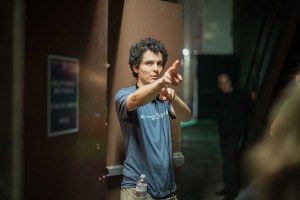
Whiplash, a low-budget sophomore effort by 29-year-old director Damien Chazelle, who also wrote the screenplay, has emerged as the dark-horse darling of this year’s movie awards season. The building buzz is that it has a good chance to get nominated for the best picture Oscar, as well as in other categories.
The film is about a young musician Andrew, played by fast-rising star Miles Teller, who aspires to get the lead drummer’s spot in a top-flight music school’s jazz orchestra. He ultimately succeeds, but not before he endures relentless bullying from Fletcher, the band’s brilliant conductor who is maddeningly abusive in his drive for perfection. Veteran TV and film actor J.K. Simmons, who dazzles as the martinet bandleader, has become one of the favorites to win the Academy Award for best supporting actor.
While most critical plaudits have so far been bestowed on the film’s stars and on Chazelle for his sure-footed direction and well-crafted screenplay, the movie’s cinematic polish and look can be attributed to the efforts of its fresh-faced team of creatives.
In putting together a crew, “the key was not only to find people who connected to the material, but were also able to meet the tough production requirements,” said the director. His ambition was to make a film that, in terms of quality and appearance, made the most out of its tiny budget. “I wanted it to look like a $10 million movie shot in 40 days instead a $3 million movie shot in 19 days, so I really needed people who could do a lot for a little.”
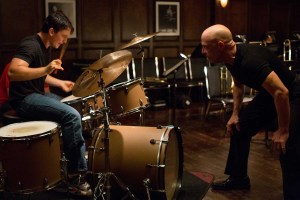
Released last month by Sony Pictures Classics, the bandwagon for Whiplash began rolling last January when the film was first screened at the Sundance Film Festival. There it scored an unusual double victory, winning both the grand-jury prize and the audience award for best dramatic film, and it went on to win hearty accolades at the Cannes and Toronto film festivals.
Whiplash has been a long-standing passion project for Chazelle, originating from his own experience as a drummer striving for success while in his high school band in Princeton, NJ. There he also faced a demanding instructor. “More crucial than anything else to me in those days was a single relationship – that between me and my teacher,” he recalled. “It is that relationship, so loaded and fraught with tension, that I really wanted to explore in Whiplash.”
He wrote the Whiplash script four years ago, and as it circulated it got onto Hollywood’s prestigious “Black List,” consisting of the most promising screenplays making the rounds. Chazelle also wanted to direct the film but couldn’t find a company ready to place a financial bet on a neophyte director. His only previous movie, Guy and Madeline on a Park Bench, was begun when he was an undergraduate at Harvard, and it went on to win a number of festival awards. He was urged to make a short version of Whiplash to prove his bona fides. It could also serve as a magnet to attract backing for a feature-length version.
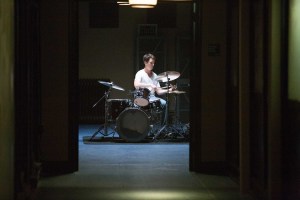 Made on a shoe-string budget of $25,000 the 13-minute version, which also starred Simmons, was shown at the 2013 Sundance Film Festival and proceeded to win the short film jury award. The prize and attention got BOLD Films to finance the movie project. It also received backing from Jason Reitman’s Right of Way Films and Jason Blunt’s Blumhouse Productions, which specializes in making films on a micro-budget – the best-known is Paranormal Activity, which was made for $15,000 and went on to gross over $193 million worldwide.
Made on a shoe-string budget of $25,000 the 13-minute version, which also starred Simmons, was shown at the 2013 Sundance Film Festival and proceeded to win the short film jury award. The prize and attention got BOLD Films to finance the movie project. It also received backing from Jason Reitman’s Right of Way Films and Jason Blunt’s Blumhouse Productions, which specializes in making films on a micro-budget – the best-known is Paranormal Activity, which was made for $15,000 and went on to gross over $193 million worldwide.
Chazelle had to put together a crew rather quickly once he got the greenlight. “The goal was to find a production team that connected to the material, and was also able to meet the tight schedule and endure the long, grueling shooting days,” he declared. “It was a tough production all around, and as a Tier One film nobody got paid very much. In the end it was pretty much a labor of love for everyone.”
He had already worked with Tom Cross, the editor, on the short, and also Jason Hurwitz, a longtime collaborator who did the score. He chose Sharone Meier, an up-and-coming Israeli cinematographer, to lens the movie. “I got so lucky with him,” said Chazelle. “Sharone is someone who really knows how to create tension with a camera, which is exactly what I wanted, and he also has a finely attuned sense of the color palette and of light.” At their first meeting, the two discussed cinematographers they both held in esteem like Conrad Hall and Gordon Willis. “We found we shared a lot of the same kinds of tastes,” he said.
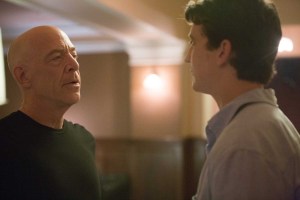 To get the most out of each day of the short shoot, Chazelle followed the well-known practice of director Alfred Hitchcock who was known for meticulously storyboarding every scene and shot in a film in advance. “Sharone and I developed a very precise shot list, so we knew where the camera was going to be at every moment,” explained the director. “At the same time we talked early on about attaining a balance of looseness and utter control.”
To get the most out of each day of the short shoot, Chazelle followed the well-known practice of director Alfred Hitchcock who was known for meticulously storyboarding every scene and shot in a film in advance. “Sharone and I developed a very precise shot list, so we knew where the camera was going to be at every moment,” explained the director. “At the same time we talked early on about attaining a balance of looseness and utter control.”
Many scenes involved tense face-to-face confrontations between the characters. “I wanted a lot of close-ups, but you can run the risk of stifling the actors,” he said. “Sharone was good at getting in tight but staying out of the way of the performers. It’s a huge testament to him and also to the actors to wind up with what got captured on camera.”
Whiplash is set in New York, but the film wound up being shot in Los Angeles, a reverse of the recent trend where other cities have stood in for L.A. “The crew infrastructure was in L.A. so we decided to shoot L.A. for New York,” said the director. It helped that his production designer Melanie Jones was originally from the Big Apple. “We talked a lot about how to recreate New York, however not the New York of today, but a darker, scarier 1970s version of New York.”
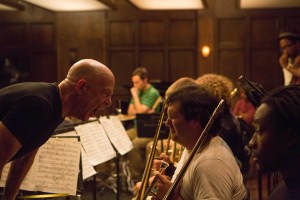 Most of the film was lensed in the Palace Theater, located in downtown L.A., with a few detours to the nearby Barclay Hotel and another old movie theater, the Orpheum. “We were really living in downtown L.A. in an area that had this wonderful mix of grit and grandeur that fit in with what we were going for,” said Chazelle.
Most of the film was lensed in the Palace Theater, located in downtown L.A., with a few detours to the nearby Barclay Hotel and another old movie theater, the Orpheum. “We were really living in downtown L.A. in an area that had this wonderful mix of grit and grandeur that fit in with what we were going for,” said Chazelle.
“Jones converted every room and crevice of the building into a different part of that movie,” said the director. The stage of the theater became the studio space where the jazz band rehearsed during long sequences. One of the upper levels became the Nassau Band rehearsal room. The space outside the lobby became the atmospheric jazz club where a climactic tête-à-tête between the two main characters takes place. Rooms in the upper floors of the Palace served as Andrew’s room, his parent’s dining room and various offices.
There was enough in the budget to pay for three days of shooting in Carnegie Hall in New York where the competition for first prize between the bands from different music schools takes place, and where Andrew ultimately triumphs with his electrifying 10-minute drum solo that brings the film to an exhilarating conclusion.
“We had one crazy day to do the drum solo during our three days at Carnegie Hall, and we had 100 set-ups,” recalled Chazelle. “We didn’t have much time to rehearse, and a lot things we had to do in one or two takes.” Multiple cameras were rolling, but everything shot was on a specific timeline and in a pre-determined order. “The storyboards I did helped a lot. We knew where the camera should be for every measure for every note, so we only got what we needed.” The footage got shipped off right away for Cross to organize and start editing.
Getting the sound right for the sequence was another challenge. The audio for the 10-minute drum solo consisted of only two takes that got stitched together. An expert drummer first laid down the overall track for Teller to learn from and it was used as playback on the set. He had learned to play drums when he was growing up, but the learning curve he had to climb to reach the proficiency needed for the film was extraordinarily steep but he pretty much managed to nail it.
Chazelle said he was very involved in the edit. “Tom and I basically lived in the editing room for 10 weeks,” he declared. But the first rough edit was done on an even more expedited schedule because the goal was to have Whiplash ready to be screened at Sundance in mid-January, and the shoot wrapped in October of 2013, leaving only a few months for postproduction. Moreover, a rough version had to be submitted even earlier, in November to determine if the film would make the cut for the festival.
The director had, meanwhile, prepared another set of storyboards to be employed as a pre-edit tool, indicating at what point a cut would take place and to what specific image. “Tom and his assistant editor John To were going nuts given the schedule. You could have conceivably spent months editing just the drum solo in the finale.”
Coming up next for Chazelle is La La Land, currently in prep, which will be “very much a love letter to the old MGM musicals – the whole song and dance,” he said. Teller and Emma Watson will star in the film. With music a central element in Whiplash as well as in his upcoming film, (his Harvard film was also about jazz), does he see this as becoming his specialty? “For now it’s something I like working with, but I’m definitely going to do a non-music movie soon so I can prove that I can do something else,” he said.





